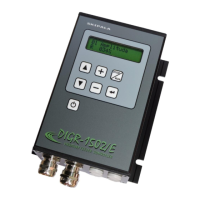17/23
Ejector E2 (Fig. 9b) – is similar to the ejector E1,
except that it uses three timers. Timer T11
(parameter A25) suppresses short impulses at the
input IN2. Timer T13 (parameter A27) determines
the delay between the signal IN2 and switching
output OUT. Timer T12 (parameter A26) determines
the length of switching output OUT.
Tip for you: Ejector E2 is good for example
for detecting the stuck parts. If parts are not
passing under the sensor for time T13 (parameter
A27) the output OUT is switched, which is
connected to the valve that controls air nozzles,
which blow off stuck parts from the feeder track.
Fig. 9b – activity of the ejector E2
Monitor IN1 ON – The output monitors the activated
status of digital input IN1. This is only
monitored when the drive is in the status RUN -
operating. If during the period set by parameter
A27 (Timer T13), there is signal 24V on input
IN1, the output OUT switches on. The signal on
the monitored input can be protected from short
impulses, which are caused by the movement of
parts under the sensor. Impulses from status 0 to
status 1 are suppressed by setting parameter A25
(Timer T11). Impulses from status 1 into status 0
are suppressed by setting parameter A26
(Timer T12). All impulses which are shorter than
the set time, will be ignored.
Tip for you: This setting can be used, for
example, if connecting the signalling beacon on
the input, to signal the shortage of components
in the magazine.

